ESG Capability Modeling Guidelines
Learn how to implement sustainable IT transformation using the ESG capability optional feature.
Overview
Note
- In the meta model v4, ESG capability is classified as an optional subtype of the business context fact sheet.
- In the meta model v3, ESG capability is an optional fact sheet type.
ESG capability is an optional subtype of business context fact sheet that enables you to develop an approach to sustainable IT. This guide offers direction on establishing a sustainable IT strategy to confront the Twin transition challenges faced by companies and overcome the obstacles of Environmental, Social, and Governance (ESG) transformations.
You will learn about the following:
- What are ESG transformations and Twin transitions, and how do they relate to Enterprise Architecture?
- Why sustainable IT is important for your business, and how can you determine where to begin your Twin transition?
- How to plan, implement, and track the progress of your sustainable IT transformation and strive towards Twin transition.
Note
By default the installer will attempt to create a relation between ESG Capabilities and the Objective Fact Sheets. In case your workspace does not contain the Objective Fact Sheet type, the installation will still succeed without it. We recommended to follow our default modelling and install the Objective Fact Sheet and create the relation manually using the Meta Model Configuration.
Activating the ESG Capability Optional Feature
As an admin, you can activate the ESG capability optional feature in the Optional Features & Early Access section of the administration area. Upon activation, the following changes take place:
- The ESG capability is added to the meta model. If the workspace is configured for the meta model v4, the ESG capability is added as a subtype of the business context fact sheet. If the workspace is configured for the meta model v3, the ESG capability is introduced as a new fact sheet type.
- A set of 44 ESG capability fact sheets, based on our recommendations, are created. The user who activated the feature is designated as the creator of these fact sheets and their associated relations.
Twin transitions & ESG: What are they, and how do they relate to Enterprise Architecture?
The Twin transitions refer to the need for organizations to transition towards a low-carbon economy to address climate change and simultaneously towards a more digitalized economy to address economic growth and development.
ESG stands for Environmental, Social, and Governance. It's a set of criteria used by investors and stakeholders to assess an organization's sustainability and ethical impact. ESG has become increasingly important in recent years as investors seek to align their investments with their values and concerns for the environment and society.
The Twin Transitions and ESG are interconnected concepts that focus on promoting sustainability and addressing environmental and social concerns. The twin transitions provide a framework for balancing economic growth and development with addressing climate change, while ESG provides criteria for evaluating an organization's sustainability and ethical impact. Organizations that adopt ESG principles are more likely to prioritize sustainability and contribute to the Twin Transitions.
Why Sustainable IT is relevant to organizations
In today's world, sustainable IT is a crucial aspect of modern organizations. As environmental concerns become more pressing, organizations must assess the impact of their IT practices on the planet. Adopting sustainable IT practices not only addresses these concerns but also offers significant benefits to the organization itself. Here are a few reasons why sustainable IT is relevant:
- The IT sector accounts for about 2% of global greenhouse gas emissions, a number that is expected to rise to 3.5% by 2025, according to Gartner. Adopting sustainable IT practices can help organizations reduce their carbon footprint and fight climate change.
- By reducing energy consumption, minimizing waste, optimizing their application portfolio, and extending the lifespan of IT equipment, organizations can achieve cost savings.
- Early adoption of IT sustainability practices can give organizations a competitive edge by preparing them for future government regulations. Compliance with these regulations can help organizations avoid penalties, fines, and reputational damage.
- Sustainable IT practices enhance an organization's brand reputation and attract more customers and employees who value environmental responsibility.
How to implement Sustainable IT Transformation with SAP LeanIX
Enterprise Architecture supported with SAP LeanIX can play an important role in supporting ESG initiatives.
SAP LeanIX provides an out-of-the-box ESG capability map to help you get started. It is a great starting guide on what you can do and what are the different areas you can focus on for your ESG initiatives. It helps you identify sustainability risks and opportunities in an organization's landscape, enabling you to develop strategies for ESG initiatives. ESG capability map report is supported by a dedicated ESG Capability Fact Sheet type.
Admins of workspaces can add the ESG Capability Map, developed in collaboration with PwC, as a landscape report to workspaces from the Optional Features & Early Access section in the Administration menu.
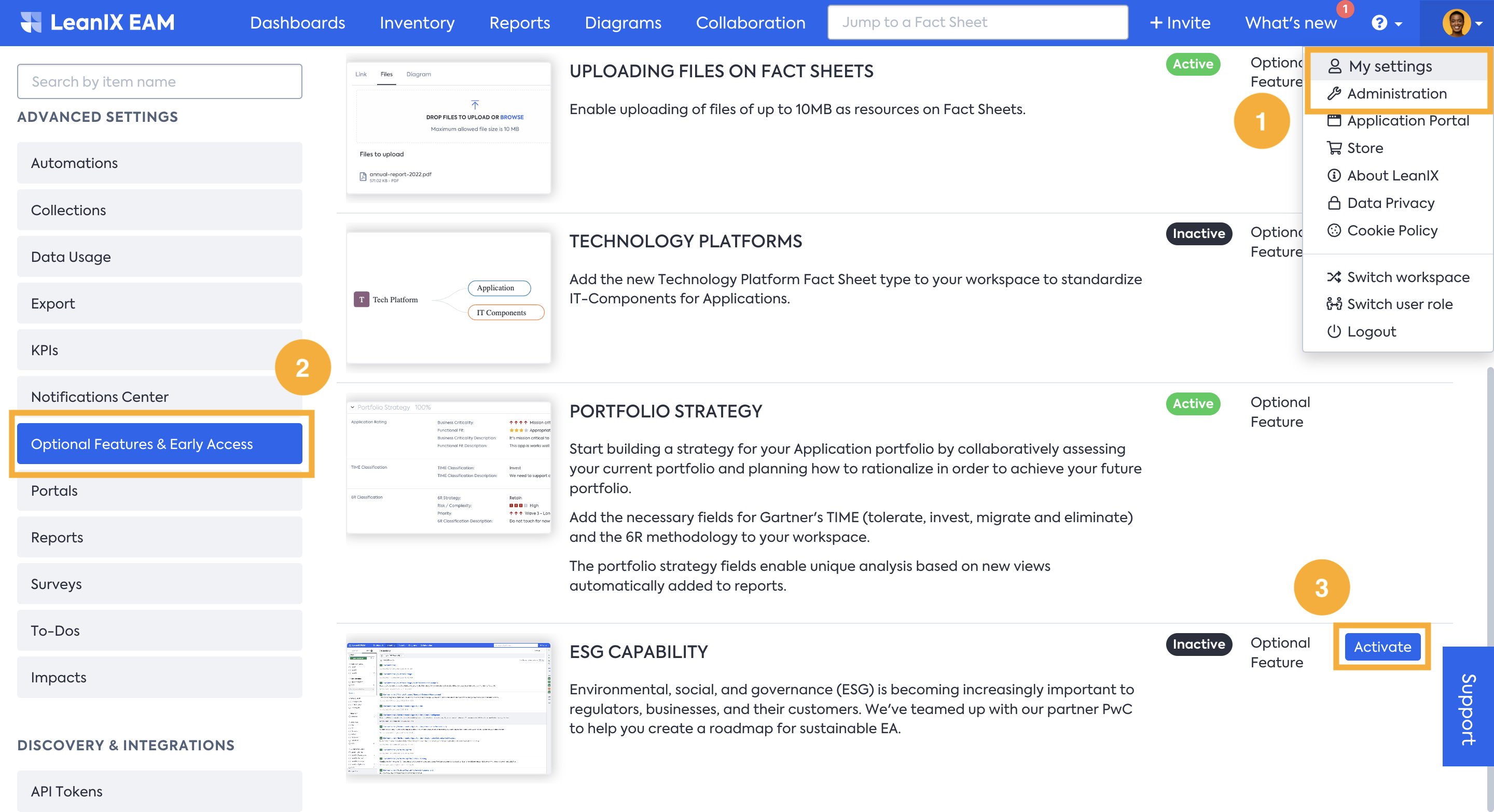
To help manage data and measure progress, SAP LeanIX focuses on five principal metrics -
- Emissions- to measure the carbon footprint
- Energy consumption - to assess the portion of renewable energy consumed
- Electronic waste - to capture lifecycle and recycling data of IT components
- Digital ethics - to capture digital ethics information
- Provider evaluation - to include the sustainability score of the provider
These five metrics are incorporated as custom attributes of various Fact Sheets such as Application, IT Component, and Provider Fact Sheets. Linking these custom attributes with the new ESG Capability Fact Sheet ties everything together to give you the ability to carry out and manage the ESG transformation.
ESG Capability Fact Sheet Subtype
The ESG capability fact sheet subtype allows organizations to collect and manage sustainability data across their Enterprise Architecture layers. This enables data-driven decision-making and measurement of the impact of ESG initiatives. This helps ensure compliance with ESG regulations and standards by providing a framework for tracking and reporting sustainability metrics.
SAP LeanIX's flexible Meta Model allows for the easy addition of new sections and fields to the ESG Capability Fact Sheets, making it convenient to collect relevant data for new ESG projects. When undertaking a Twin transformation, relevant data may vary, but the ESG Capability Fact Sheet serves as a starting point to identify necessary metrics. Users with Admin rights can effortlessly add new fields to relevant Fact Sheets to collect data once defined.
Below illustration shows such custom attributes you can create in the Fact Sheets. Take it as an inspiration and create fields and relations as per your requirements.
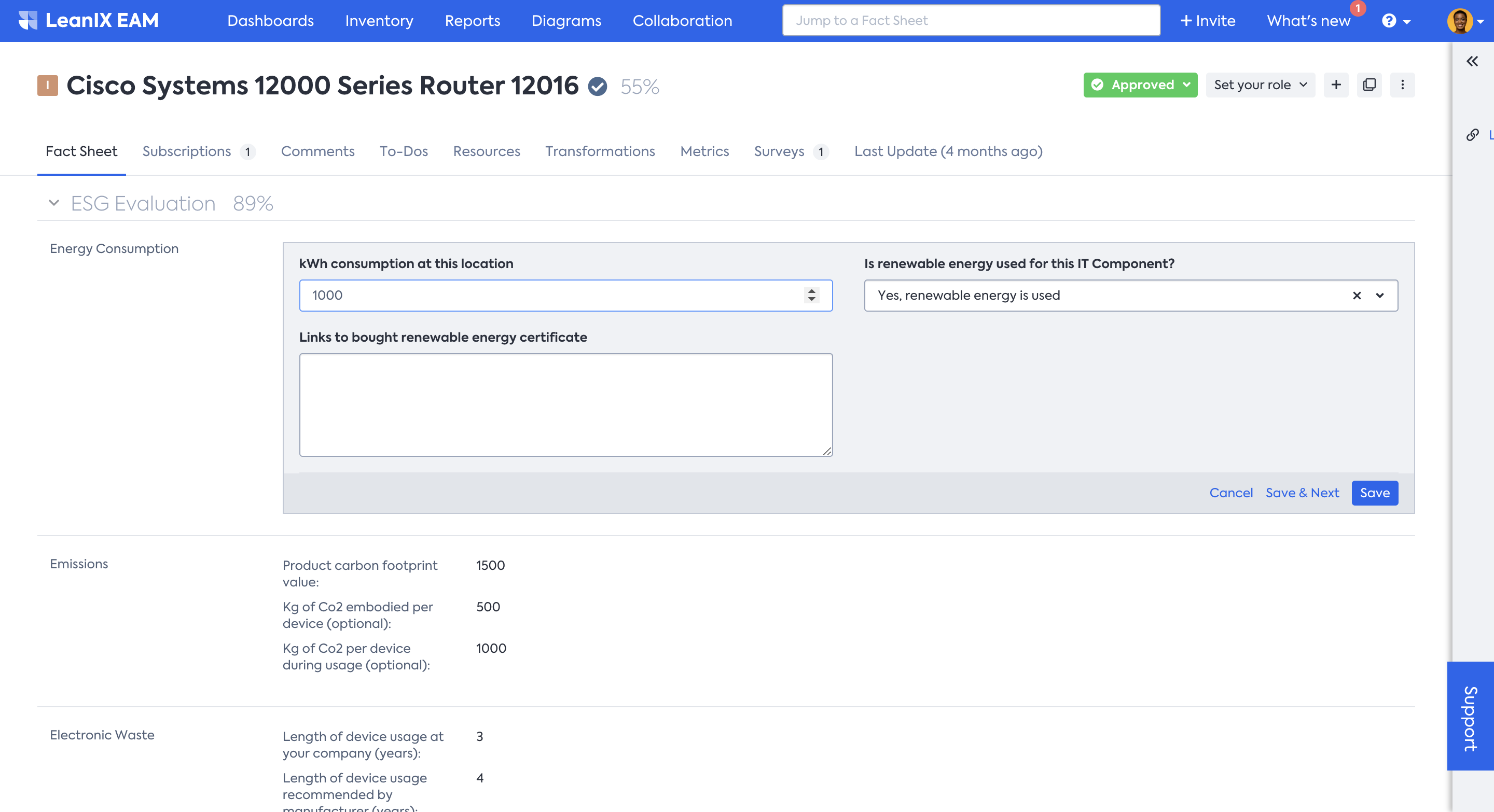
Collaborate and collect data
SAP LeanIX offers collaborative capabilities that enable teams to gather data efficiently. One useful collaboration feature is Surveys, which allows gathering information from subject matter experts and those responsible for the architectural elements, modeled via subscription roles in the Fact Sheets, to provide insights. In case some data is already stored in a file, Excel importing functionality can be used to transfer the information to SAP LeanIX.

Monitor the progress of data collection by using the different mechanisms offered by SAP LeanIX, such as the quality seal and the survey administration area, or by creating a dashboard with the targeted fields as custom chart widgets.
Strategize with the ESG Capability Map
SAP LeanIX's ESG Capability Map provides CIOs, EAs, and CSRs with guidance for developing a strategy to support their organization's Twin Transition. It offers a comprehensive overview of ESG topics, initiatives, and key performance indicators (KPIs) that can help identify areas for improvement.
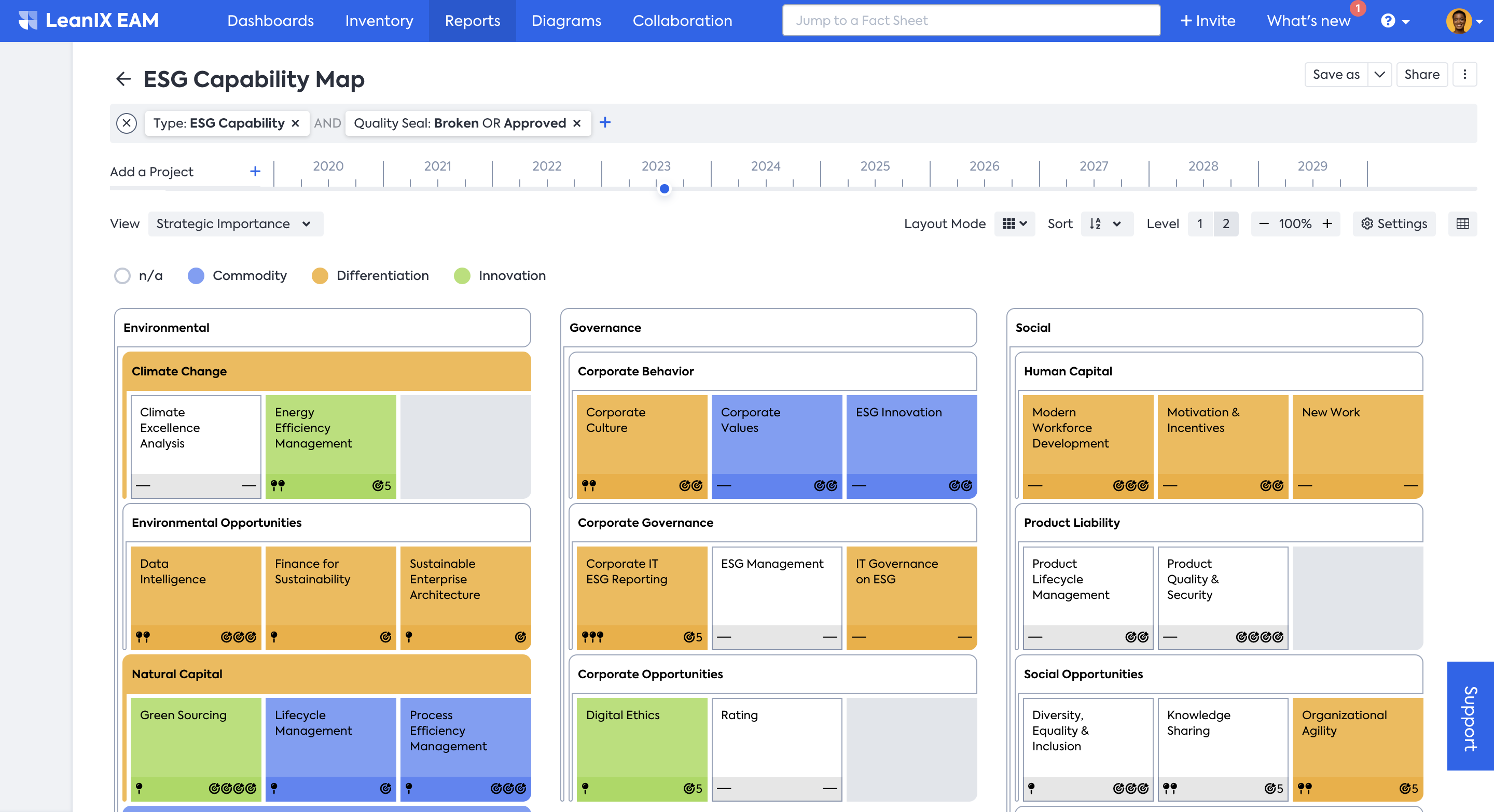
By navigating to any of the ESG Capability Fact Sheets, users can access the respective Fact Sheet for a more detailed understanding of each capability, including its IT implications of the capability. After understanding each capability, users can evaluate their strategic importance and assess their current and target maturity. This evaluation can be done by the CSR representative or the EA in charge of the topic.
Plan Twin transitions in SAP LeanIX
With SAP LeanIX, users can create projects specific to each ESG capability, providing a clear scope and description. The platform also allows users to filter and identify architectural elements impacted by the project through the Project Fact Sheet. This feature enables organizations to bridge the gap between identifying areas of improvement and taking concrete action toward progress.
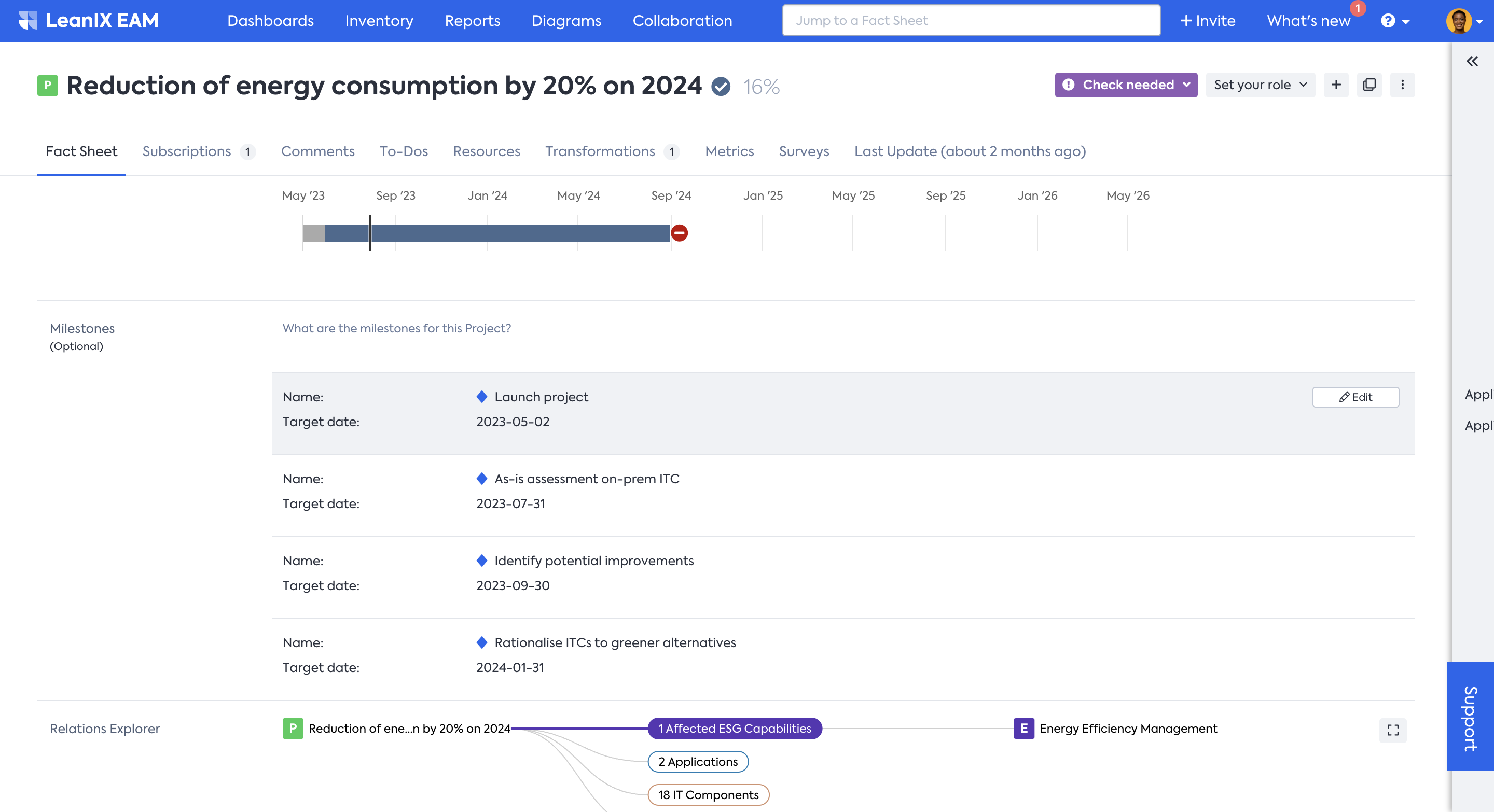
With the use of SAP LeanIX Architecture and Road Map Planning, architectural elements that are within the scope of the project can be modeled. This means that companies can have a holistic view of how their Enterprise Architecture is undergoing Twin Transitions.
To effectively track and describe the changes in the application landscape during the transition, the Transformation Explorer of SAP LeanIX Architecture and Road Map Planning can be used. This feature provides a comprehensive list of changes being made to your IT landscape as part of your project, allowing you to keep track of the progress of your transition.
Track and Report your progress
SAP LeanIX Reports provides a comprehensive view of your architecture's current state in relation to ESG, which helps you in decision-making, tracking progress, and identifying trends. By generating reports, you can analyze information from various angles and identify areas where improvements can be made.
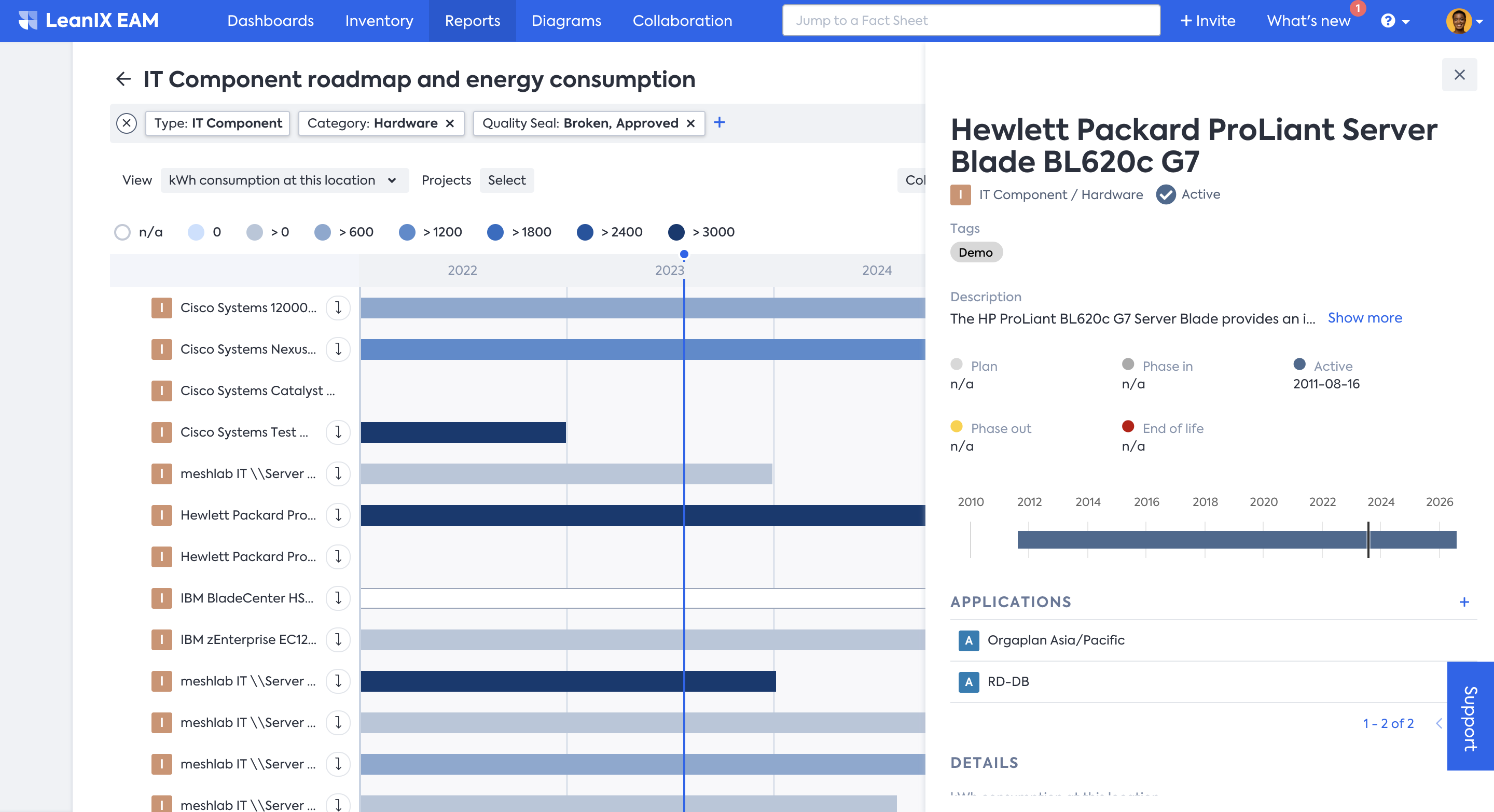
In the above example, the Roadmap report presents data on the energy consumption of different hardware components used by the company, along with their technology lifecycle information. By examining the report, we can pinpoint specific IT components that consume higher energy (highlighted in dark blue) and are nearing the end of their useful life. To gain a better understanding, we can click on each of these components to gather additional contextual information.
Make use of SAP LeanIX custom dashboards to combine multiple visualizations and tell a compelling story. Drive conversations by presenting all relevant ESG information in new dashboards you create with embedded metrics, KPIs, and reports.

To learn more about creating custom dashboards to track and report, refer here.
To summarize, SAP LeanIX reports provide excellent opportunities to address your inquiries and make informed decisions regarding your ESG capabilities. This will enable you to take a significant step toward the Twin Transition.
Updated 22 days ago
